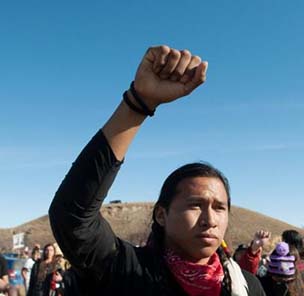Native American Heritage Month: Standing Rock Resistance

image from the New York Daily News 11.6.16.
Our final feature for #NativeAmericanHeritageMonth honors the resistors fighting for their sacred land in North Dakota. After centuries of displacing and murdering the indigenous people of the United States, the U.S government have come into two different agreements with members of different tribes under the Treaty of Fort Laramie: 1851 and 1868. In 1851, the US agreed to grant annuity to the respective tribes for $50,000 for fifty years, allowing settlers to go along the Oregon Trail to reach California during the Western migration and expansion. The Dakota people would in return be living separately from white settlers and continue living their agricultural lifestyle. In 1868, the US agreed to give the Lakota ownership of the Black Hills (Sioux reservation land) and hunting rights in Wyoming, South Dakota and Montana.
Why is this relevant today? Because the Dakota Pipeline Project, initiated by the Dakota Access, LLC, a unit of the Texas-based Energy Transfer Partners violates the Treaty of Fort Laramie. The 3.78 billion dollar project would rub 1,172 miles from North Dakota’s northwest Bakken region down to a market hub outside Patoka, Illinois; which would be crossing sacred Native land, and contaminating the main water source that the Standing Rock Sioux use for every aspect of their day-to-day lives.
The Hunkpapa, Yanktonai, Cuthead and Blackfoot tribes of the Great Sioux Nation and water protectors of these sacred lands are going through extreme reproductive and environmental injustices as the US government continuously pushes forward with this project. As we deconstruct what reproductive justice is, we remember it expands past one’s right to an abortion. Reproductive justice is in essence an intersectional theory emerging from the experiences of reproductive bodies of color whose multiple communities experience a complex set of reproductive oppressions. When water sources are threatened, the livelihood of these communities are threatened. The ability to nurture the reproductive body is under attack, displacement skyrockets, and the risk of pre-term deliveries, miscarriages and low birth weight in infants are results of the injustices facing maternal and child welfare of the Native community. This is not new to the history of the U.S. government and their role in policing Native bodies, as they’ve been victims to sterilization and severe underfunding for prenatal care.
One’s proximity to clean water is not a coincidence either, but further illustrates the impacts of environmental racism (when marginalized communities are subjected to disproportionate exposure of pollutants and the denial of access to sources of clean air, water, and natural resources). As the Standing Rock Sioux fight for sovereignty and reclaiming their space, we at the Reproductive Health Access Project understand that clean water is a human right, and a reproductive right.
